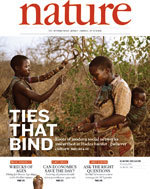
Social Networks and Cooperation in Hunter-Gatherers (Nature, 2012)
Abstract
Social networks show striking structural regularities, and both theory and evidence suggest that networks may have facilitated the development of large-scale cooperation in humans. Here, we characterize the social networks of the Hadza, a population of hunter-gatherers in Tanzania. We show that Hadza networks have important properties also seen in modernized social networks, including a skewed degree distribution, degree assortativity, transitivity, reciprocity, geographic decay and homophily. We demonstrate that Hadza camps exhibit high between-group and low within-group variation in public goods game donations. Network ties are also more likely between people who give the same amount, and the similarity in cooperative behaviour extends up to two degrees of separation. Social distance appears to be as important as genetic relatedness and physical proximity in explaining assortativity in cooperation. Our results suggest that certain elements of social network structure may have been present at an early point in human history. Also, early humans may have formed ties with both kin and non-kin, based in part on their tendency to cooperate. Social networks may thus have contributed to the emergence of cooperation.
WATCH VIDEO: Dawn of Social Networks: Hunter-gatherers Provide Clues About the Evolution of Cooperation
Coren Apicella, a research fellow in the Christakis lab at Harvard Medical School, spent the summer of 2010 traveling around the remote Lake Eyasi region of Tanzania with the Hadza, one of the last remaining populations of hunter-gatherers on the planet. Their lives offer a window into our past-and clues about the evolution of cooperation. Within the Hadza community, cooperators cluster together, preventing self-interested individuals from destroying the social fabric. What's more, the architecture of the Hadza social network matches that of modern social networks. These findings were published January 26, 2012, in Nature.
Citation:
C.L. Apicella, F.W. Marlowe, J.H. Fowler, and N.A. Christakis, "Social Networks and Cooperation in Hunter-Gatherers" Nature, 481(7382): 497-501 (January 2012)